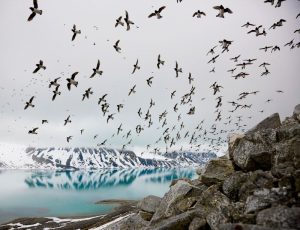Researchers at the National Audubon Society analyzed how climate change will effect birds in the United States National Park System. Birds are sensitive to their environment. They are mobile, responsive, and conspicuous. Birds are also an economic attraction to National Parks, contributing $107 billion to the industry for bird watching. To determine how birds would be impacted, Wu and their colleagues analyzed 513 species across 274 national parks based on high and low greenhouse gas scenarios. They used their analysis to determine the climate suitability of the birds. Afterwards, they classified the species under five categories: improving, worsening, stable, potential colonization, and potential extirpation (local extinction).

From their results, 24-50% of these birds are highly vulnerable to climate change. Also, highly sensitive birds are 21% more likely to lose half of their climatic suitability by mid-century. Birds from the Great Lakes region, most migratory species, were more likely to be vulnerable species. Despite most of these species categorized as vulnerable species, their model predicted that potential colonization are more likely to occur than extirpation during a high greenhouse scenario. More potential colonies transpire in the winter, 42.1 species, rather than the summer, 22.5 species. This would increase the species richness within the parks, which measures the count of species within an ecological community. Wu and their coauthors explain that birds are responding to warmer winters by making more colonies in the North, such as the Midwest and Northeast. During the stage of potential colonization, the present conditions for the birds are dismal, but they are projected to improve overtime to be suitable in that location.
Researchers at the National Audubon Society analyzed how climate change will effect birds in the United States National Park System. Birds are sensitive to their environment. They are mobile, responsive, and conspicuous. Birds are also an economic attraction to National Parks, contributing $107 billion to the industry for bird watching. To determine how birds would be impacted, Wu and their colleagues analyzed 513 species across 274 national parks based on high and low greenhouse gas scenarios. They used their analysis to determine the climate suitability of the birds. Afterwards, they classified the species under five categories: improving, worsening, stable, potential colonization, and potential extirpation (local extinction).
From their results, 24-50% of these birds are highly vulnerable to climate change. Also, highly sensitive birds are 21% more likely to lose half of their climatic suitability by mid-century. Birds from the Great Lakes region, most migratory species, were more likely to be vulnerable species. Despite most of these species categorized as vulnerable species, their model predicted that potential colonization are more likely to occur than extirpation during a high greenhouse scenario. More potential colonies transpire in the winter, 42.1 species, rather than the summer, 22.5 species. This would increase the species richness within the parks, which measures the count of species within an ecological community. Wu and their coauthors explain that birds are responding to warmer winters by making more colonies. During the stage of potential colonization, the present conditions for the birds are dismal, but they are projected to improve overtime to be suitable in that location.
These projections are important to park management and policy. The current management style focuses on landscape-scale conservation. However, the authors suggest the National Park Service adopt a climate-informed conservation strategy that increasing habitat mobility and restoration. From this strategy, the authors hope to instill resistance (protecting highly valued resources) and resilience (improving species capacity).
To learn more about the effects of climate change on birds, follow the links below:
http://climate.audubon.org/
https://climatekids.nasa.gov/extreme-weather-birds/
Source:
Wu, J., Wilsey, C.B., Taylor, L. Schuurman, G.W. 2018. Projected avifaunal responses to climate change across the U.S. National Park System. PLOS ONE: https://doi.org/10.1371/journal.pone.0190557
